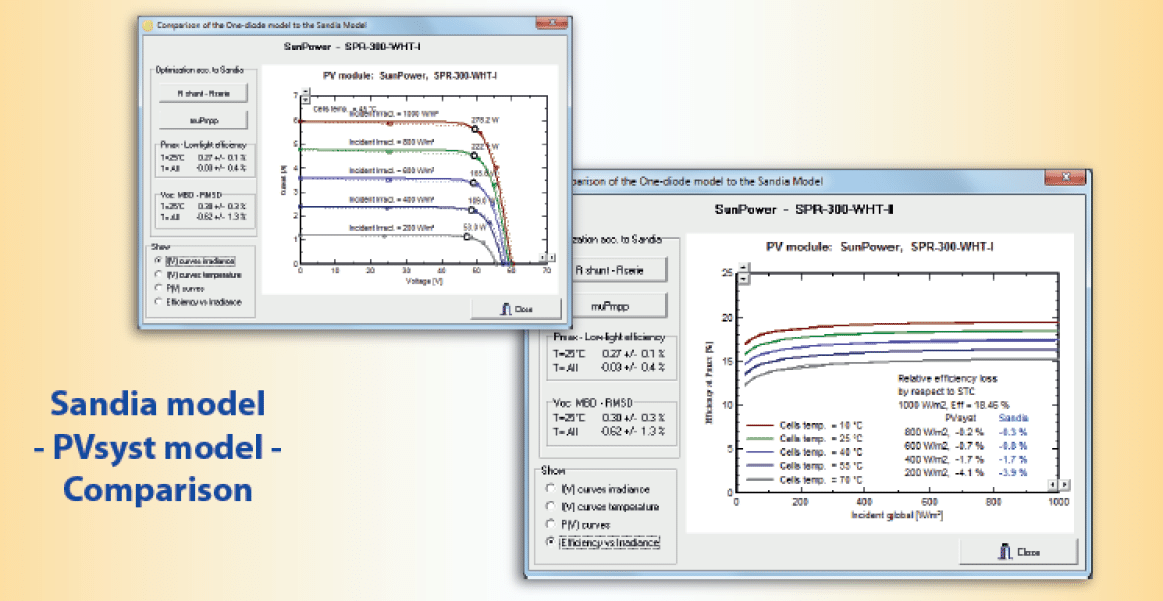
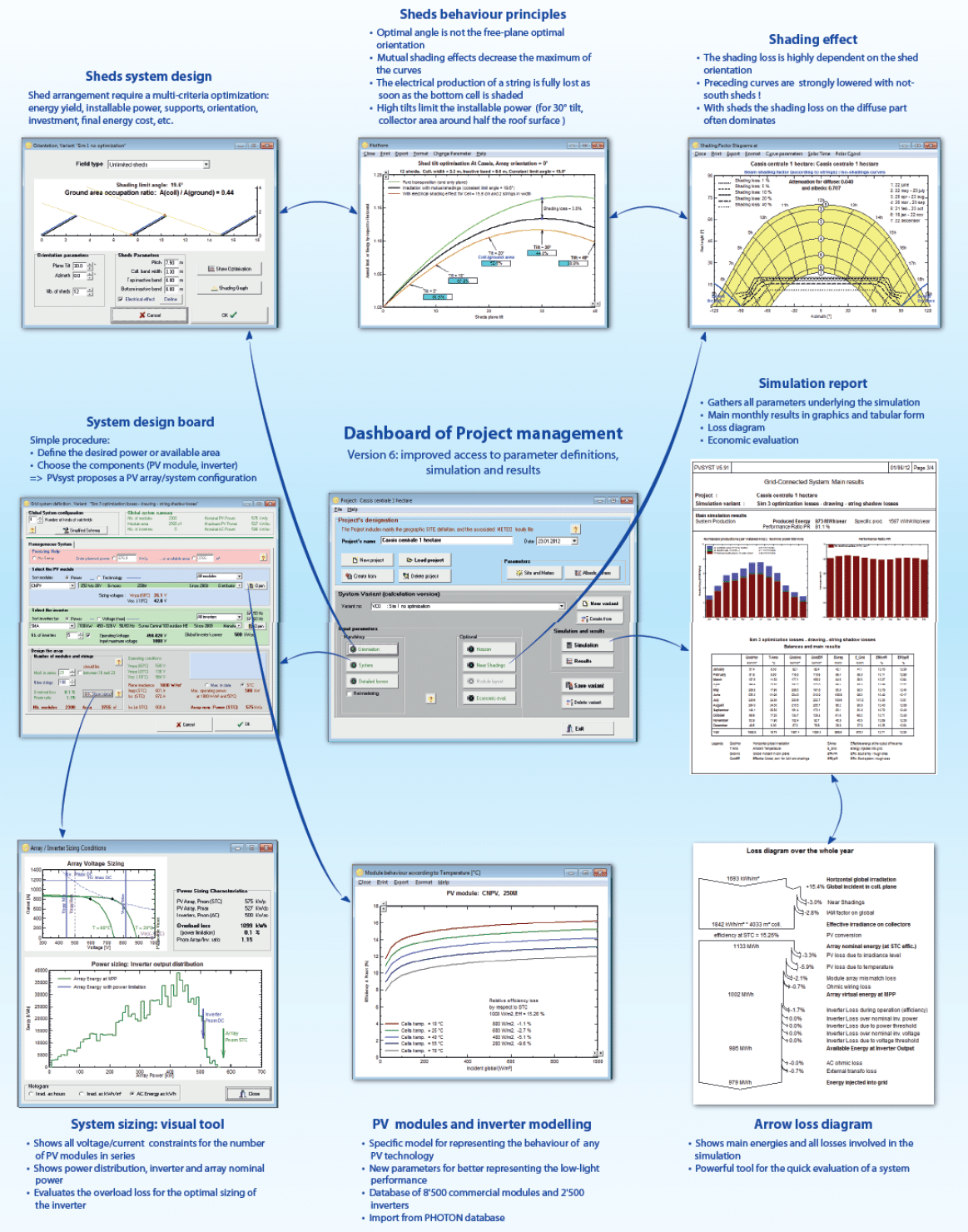
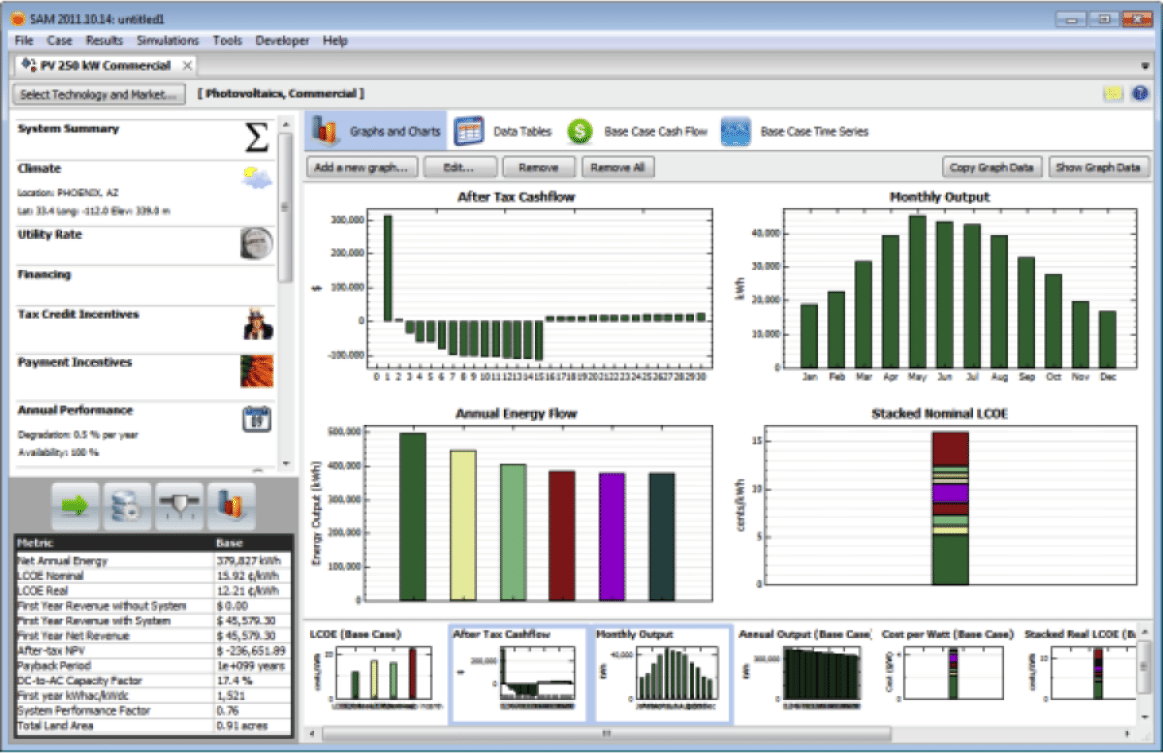
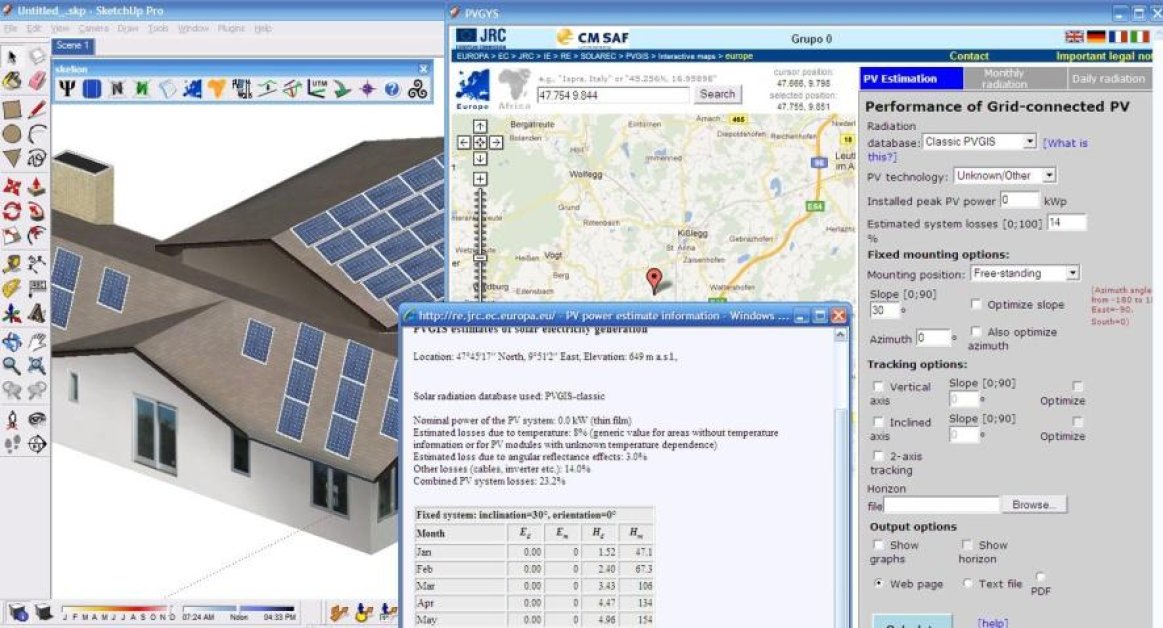
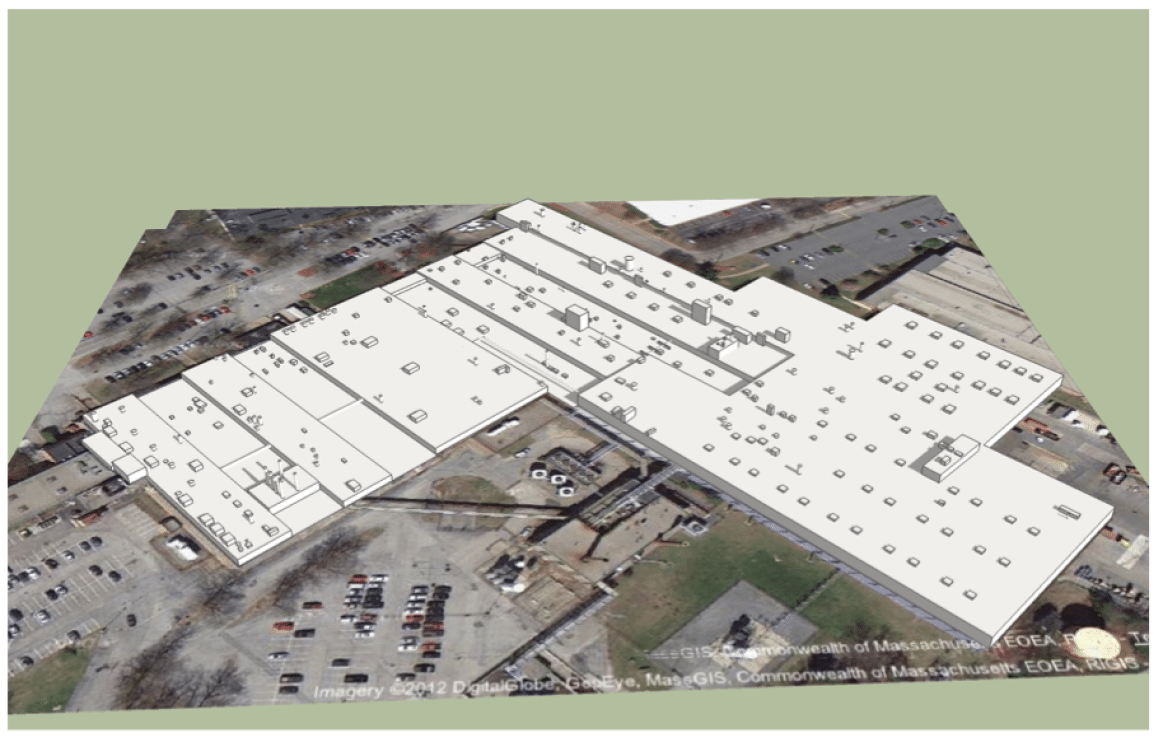

The Evolution of PV Design
The design process for photovoltaic systems has, for the most part, transitioned from a simple electrical equation to a complicated three-dimensional architectural, solar and financial analysis. The anachronistic equation of amps out to amps in, needed to figure out how a twelve volt module could refill a twelve volt battery, has proved inadequate for today's PV systems, which are connected to the public electrical grid and draw on a wide variety of inputs. Not coincidently, the connection of our PV systems to the energy 'cloud' has fostered a boom in modeling software in the internet cloud. The following is a basic survey of some of the notable players in the PV Design arena today.
1) PV Syst , Windows only, download
PV Syst is one of the most complex PV performance and financial model design tools in the industry. It's one of the first commercially available PV design packages - initially written for small off-grid systems in Europe, then evolving into more complex software that is capable of precise output design of utility scale projects. PV Syst is arguably the industry standard globally and is both loved and hated by the professional PV designers who use it every day. PV Syst has seen a gradual erosion of its position by free and web based offerings (below) and, in response, has made an effort to enhance its offering, which is currently in version 5.
Some of the new features that will be available in the sixth version of the PV Syst software, to be released within a few months, include: (i) direct search of a location using Google map; (ii) direct shading calculation during the simulation (avoiding interporlation uncertainties) – figure 1; (iii) new outputs such as “irradiance shading loss” and “electrical shading loss” position; (iv) improved project management parameters access copy, templates – figure 2; and (v) for PV modules – Sandia model implementation and comparison – figure 3 and tools for parameter optimization (low-light, I/V curve).
Key features: Preliminary design, Shading analysis, 3-D project design with geographic solar orientation, technical output analysis, economic and financial analysis, geographical solar insolation
Price: ~$1050 USD
2) PV*SOL – Expert, Pro and Basic, Windows only, download.
PV*SOL software was designed by Gerhard Valentin and is owned by the Valentin Company. The software is available in three different versions (Expert, Pro and basic) depending on how many features you would like to use and what depth of analysis you're looking for. PV*SOL was originally written in Fortran almost 20 years ago - it's a powerful software package, but the user interface can sometimes reflect the age of the software.
PV*SOL Expert is a 3D design tool for simulating system performance. This version is most recommended for installers, engineers and architects who want to visualize shading and configure PV module coverage in great detail – source: http://www.solardesign.co.uk/pv.php
PV*SOL Pro is a 2D simulation program for the design and calculation of photovoltaic system performance. PV* SOL Pro is suitable for installers and engineers who need to design grid-connected or standalone PV systems with a high degree of accuracy – source: http://www.solardesign.co.uk/pv.php
PV*SOL basic is the entry-level program for designing grid-connected photovoltaic systems. Recommended for sales staff and installers who need a reliable tool to design PV system quickly and precisely. – source: https://www.solardesign.co.uk/pv.old.php
The Company offers trial demos of the three versions of PV*SOL in its website, and also provide FREE webinars for online training.
Key features: Preliminary design, 3D and 2D simulation, shading analysis, technical output analysis, economic and financial analysis
Screenshots: http://www.solardesign.co.uk/pvsol-expert.php
Price: $1543 USD
3) System Advisor Model (SAM), Windows or MAC OSX, download
Developed by NREL, it’s the most advanced and commonly used performance and financial tool in the USA. The software is not only designed for (residential, commercial and utlity scale) PV, but also other renewable technologies such as dish-stirling CSP, solar-water heating, small and large wind and biomass projects. The SAM UI looks and feels like a government project. The designers at NREL have taken the stodginess of PVSyst and PVSol and updated their 1980's Volvo functionality to the 1990's Cadillac level excess. The awkwardness of the design is a good thing - it proves that SAM was made by PhD level engineers! Despite feeling clunky to use, SAM is a fantastic tool - providing almost endless tweaks and customizations to get your overall model right where you want it - plus, it's free.
SAM can provide performance predictions and cost of energy estimates for grid-connected power projects based on installation and operating costs and system design parameters that you specify as inputs to the model. The current version of the SAM includes performance models for the following technologies: (i) Photovoltaic systems (flat-plate and concentrating); (ii) Parabolic trough concentrating solar power systems; (iii) Power tower concentrating solar power systems (molten salt and direct steam); (iv) Linear Fresnel concentrating solar power systems; and (v) Dish-Stirling concentrating solar power systems.
SAM includes several databases of performance data and coefficients for system components such as photovoltaic modules and inverters. For those components, you simply choose an option from a list. SAM can also automatically download data from an online database of retail electricity rates and structures for U.S. utilities. For the remaining input variables, you either use the default value or custom. Some examples of input variables are: (i) Installation costs including equipment purchases, labor, engineering and other project costs, and land costs, and operation and maintenance costs; (ii) Numbers of modules and inverters, tracking type, derating factors for photovoltaic systems; (iii) Collector and receiver type, solar multiple, storage capacity, power block capacity for parabolic trough systems. (iv) Analysis period, real discount rate, inflation rate, tax rates, internal rate of return target or power purchase price for utility financing models; (v) Building load and time-of-use retail rates for commercial and residential financing models; (vi) Tax credit and payment incentives amounts and rates.
SAM displays modeling results in tables and graphs, ranging from the metrics table displaying levelized cost of energy, first year annual production, and other single-value metrics, to the detailed annual cash flow and hourly performance data that can be viewed in tabular or graphical form. All graphs and tables can be exported in various formats for inclusion in reports and presentations, and also for further analysis with spreadsheet or other software. Did we mention that this is all free?
Graphs and Charts on the Results page displays graphs of results that you can easily export to your documents.
SAM's performance model makes hour-by-hour calculations of a power system's electric output, generating a set of 8,760 hourly values that represent the system's electricity production over a single year.
SAM's financial model calculates financial metrics for various kinds of power projects based on a project's cash flows over an analysis period that you specify. The financial model uses the system's electrical output calculated by the performance model to calculate the series of annual cash flows. SAM includes financial models for the following kinds of projects: (i) Residential and Commercial Projects; (ii) Power Purchase Agreement (PPA) Projects; (iii) Levelized Cost of Energy and Cash Flow (levelized cost of energy (LCOE) after-tax cash flows for projects using retail electricity rates, and from the revenue cash flow for projects selling electricity under a power purchase agreement); and, (iv) Incentives (the financial model can account for a wide range of incentive payments and tax credits).
Key features: Preliminary design, technical output analysis, economic and financial analysis, geographical solar insolation, Free.
Price: Free. If you pay taxes in the US, then you have helped to develop this tool.
4) Solmetric PV Designer Software, Windows, download
Solmetric software was written to support the Solmetric SunEye site survey tools. Like the SunEye firmware, it appears to be written in some form of Visual Basic and/or Windows Mobile; it's not pretty. If visual quirks can be tolerated, the PV Designer is a noteworthy and useful tool. The Solmetric SunEye was the first site survey device to take the steampunk style Solar Pathfinder and drag it into the 20th century by essentially adding batteries and the ability to capture and edit shading images. PV Designer goes one step further by coding the whole process and facilitating the editing and reporting of shading results. Many designers forgo the PV Designer product and import the SunEye data directly to SAM, PVSyst or others.
Designed particularly for residential and commercial roof projects where the user can drag and drop solar panels on the user-interface, it includes worldwide solar panel and inverter database, in addition to Solmetric’s weather data.
Key features: Preliminary design, shading analysis, technical output analysis, economic and financial analysis
Price: $400 USD, but you need the $2000 SunEye to generate shading data.
4.5) Solmetric Compound Angle Tool, Android, download
This is a tangential product by Solmetric that had to be noted for its simple beauty: Take any roof angle and azimuth and instantly visualize the previously maddening combined azimuth and tilt that results from non-parallel or off-axis module array mounts. Price: Free
This is a tangential product by Solmetric that had to be noted for its simple beauty: Take any roof angle and azimuth and instantly visualize the previously maddening combined azimuth and tilt that results from non-parallel or off-axis module array mounts. Price: Free
5) Solar Design Tool, Cross platform, cloud based
A web-based application that is designed for residential and commercial PV projects. Its easy to use interface and monthly subscription method makes the Solar Design tool a very attractive option. The Solar Design Tool is developed by Derek Mitchell, a Silicon Valley engineer based in Santa Cruz, CA.
The UI in Solar Design Tool is pure Web2.0+; clean, fast and with almost constant updates. Module and inverter lists stay current as does weather data with no annoying downloads to wait for.
One of the most valuable aspects of this tool is the convenient ability to quickly generate both preliminary designs and fully fleshed ones. Some software require tiresome forms and cross checks just to see if a string size works - that is not the case here.
Key features: Preliminary design, drag-n-drop module on roof, weather data, technical output analysis, web based collaboration with several users
Price: $7- $25- $45 per month. Free trial available.
6) Skelion for Sketchup, Cross-platform, download
Skelion is a bit of an outlier here, being a Plugin for Trimble SketchUp. The use of SketchUp became very popular during the blossoming of the solar industry in Europe due to its powerful 3D graphics and easy use. The 3D warehouse of shared models fostered the development of solar component designs and Skelion took the process a couple of steps further by automating the population of PV modules onto a roof surface, then running a basic PV Watts production calculation.
Simple to use; just select a surface where the solar panels will be inserted and click on the solar cell icon. A menu appears that asks you about tilt and orientation for the panels, the type of panel, and a shading range for a given day. Photovoltaic panels can be selected from its own database or you can create your own, and they can be placed in portrait or landscape orientation. After that, the plugin automatically inserts the solar panels on your selected surface. It also works with irregular surfaces.
Helpful information about the use of Skelion and its features can be found in the videos available in its website (http://skelion.net) and in also its blog, which contains several relevant topics related to the design of photovoltaic system in general.
Price: Free, limited version and $133 USD pro version.
7) Helioscope / The Solar Model, Cross platform, cloud based
Just emerging from Beta, Helioscope is poised to be the one of the most advanced PV modeling tools available.
A user defines their array, then HelioScope calculates the performance of each component in the array, including modules, wires, combiners, and inverters. If a system has 10,000 modules, that means 10,000 IV curve calculations for each of the 8760 time periods.
For advanced shade calculations and conductor length estimations, users can import 3D models from Google Sketchup directly into HelioScope - combining the power of Google Sketchup for 3D modeling with HelioScope’s production simulation engine.
Helioscope can calculate module-level energy results with the output being a 'heatmap' indicating the modeled profitability of each module. The software can also look at the effect of DC optimizers on overall production and run competing scenarios.
Helioscope aims to be a designer's primary tool, with customizable PDF reports.
Engineering firm BEW has been validating the Helioscope model results. The Helioscope target is to be as accurate as PVSyst - and possibly more so with the component based approach - but with a much more usable workspace and platform agnostic distribution.
Summary
The tools surveyed have some notable differences, but they can all be used effectively in modeling PV output and presenting the results. It will be interesting to see if the older software suites are encouraged to look beyond a static Windows Only market. Apple Computer, for instance, has about a 10% share of the workstation OS market, but it could be argued that they are a growing concern and should be considered as a viable project design platform. Regardless of operating system, the Cloud is likely to emerge as the most logical place for installing design software that is dependent on a dynamic range of products and specification.
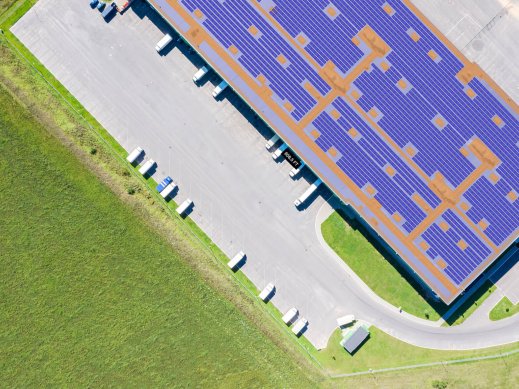

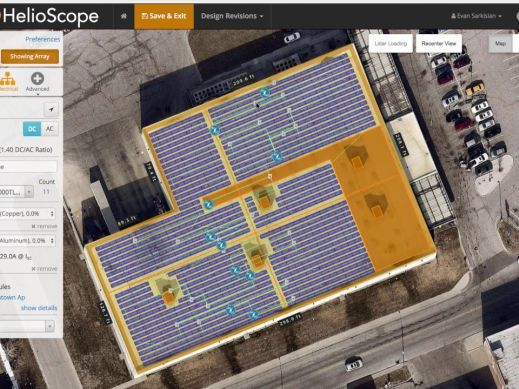

Comments
Hello
There's also EasySolar app which is the first PV design app available on browser, Android, iPhone and soon- WindowsPhone. Is's far more than a solar calculator and more efficient and user friendly than desktop software.
General features are: cloud based, cross platform, PV design on Google Maps, image or sketch, full financial analysis (many currencies and support mechanism types), unlimited number of projects and proposals in PDF, shading simulation tool, azimuth easurement, rooftop inclination measurement, subscription plan is 20 euros a month and it is translated into 4 languages.
Thanks for sharing this solar PV software. You can find free and opensource solar PV software list at engineeringpassion com and look search of the best free solar PV design.
This article does a great job of highlighting practical aspects of renewable energy adoption. The emphasis on how different solar technologies are applied in real-world scenarios is both informative and inspiring. It’s always fascinating to see how advancements in solar energy systems continue to drive the industry forward.
For those looking into optimizing solar project designs, tools like Virto.Solar can be a great resource. They streamline the design process for residential, commercial, and utility-scale systems, ensuring efficiency and accuracy.
Thank you for sharing such useful insights—it's a great read for anyone involved in the renewable energy space!